Living Green With Pets: Bringing Plants Indoors
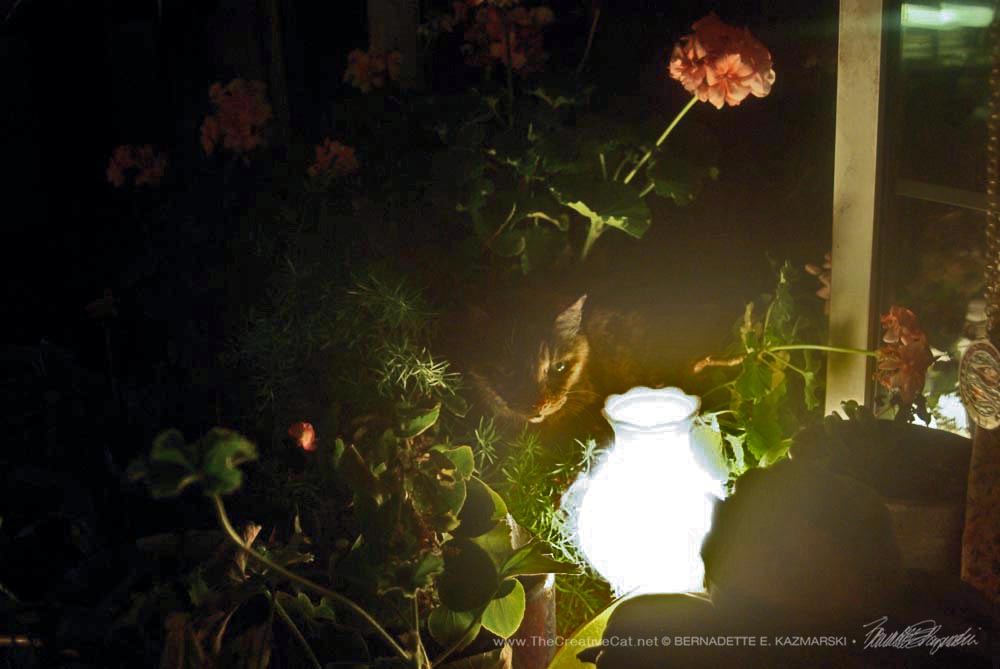
BRINGING PLANTS IN from the outdoors for winter is a great way to enjoy a little greenery indoors during winter months and save money on gardening costs next spring. But anything you bring into your home is subject to inspection by your pets, and cats especially are famous for eating houseplants and doing a little digging, so be aware of plants you’ve fed with chemical fertilizers, check for pests and diseases and only treat plants with safe, non-toxic methods, and identify which plants may be toxic to your pets and consider another home for toxic plants.
. . . . . . .
Above, Cookie decided to have a nap in the geraniums and begonias I’d brought in from the outdoors the very first night they were in, as if I’d set it all up for her. She was 19 years old, but that didn’t make a difference because she’d been doing this since she was a kitten. Well, that’s how cats are, I should know this—everything really is all set up for them. Cat naps may be one use for your houseplants, but it’s not something many people want their pets to do. However, I understood there was no way to stop Cookie except by moving the plants, which I eventually did. I don’t have any plants that are toxic to my cats, though if they munch away on a few they may get an upset tummy and vomit green somewhere I’d prefer they didn’t so I’m still careful.
Some plants are toxic, most can cause an upset stomach—find out which is which for each of your plants before you bring any inside. Eating even just a little of any plant can cause gastric upset, vomiting, gagging and even choking. Feline teeth are not intended to chew stems and leaves, and their gut is not intended to digest them, dogs can handle plants a little better. Most cats will be fine with a little exploration, some can become very ill. If your cat overdoes it and you can’t move the plants out of her way, you should find another home for your plants.
These cautions when bringing house plants and garden plants indoors, including the use of chemicals on the plant and in the soil, removing insects from the plant and soil, and placing them in a safe place for you and your cats.
Bringing plants indoors
I was caught a little off-guard that year when we had an unexpected snowfall in October a few years ago, right when the geraniums were looking their best and even plenty of tender plants were still blooming. While I’d known for weeks I needed to plan for what to do with my plants before they ended up as frozen mush, the first snowfall was still a surprise.
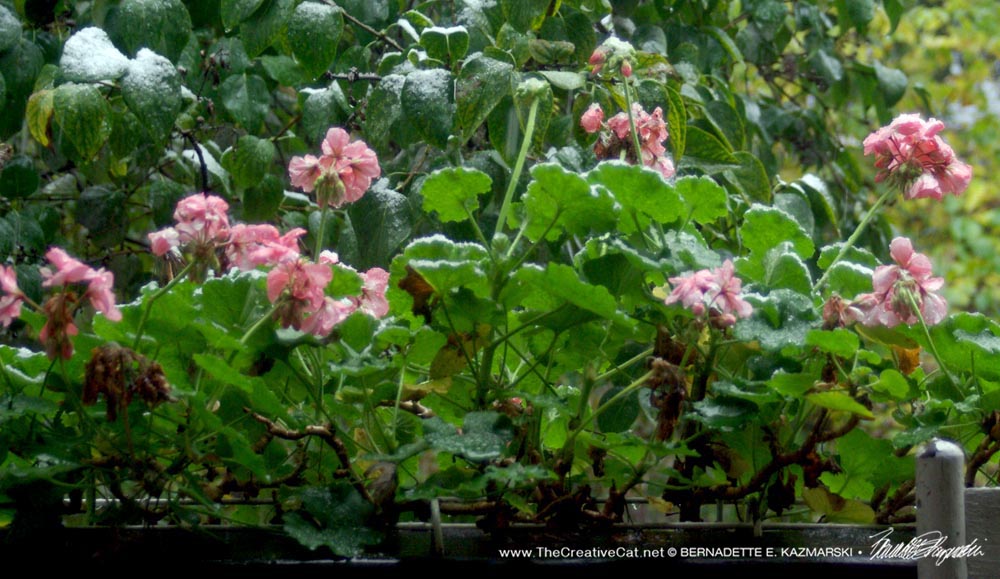
However this year we had a freeze, and while more tender plants will be tinged with air cold enough to produce snow, it’s also full of moisture which helps to protect leaf and petal surfaces, and plants under cover of a deck or tree aren’t as badly affected. A freeze is typically cold with a clear sky and low humidity, and any plant outdoors that has moisture in its leaves is pretty much done for so this year my kitchen table is covered with plants and an equal number have been crowded into the basement.
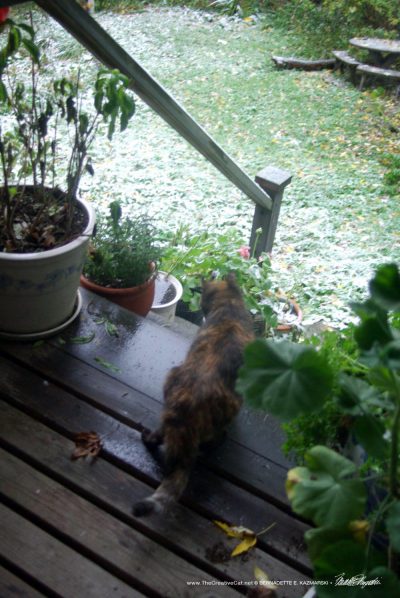
Often annual, semi-annual and perennial plants are thriving in the autumn, into a second bloom after the heat of late summer is moderated by the cool dampness of early autumn. Many plants can be brought indoors and kept as houseplants through the winter, which saves you both time and money next spring when you can start with plants that are already growing.
You may have a variety of plant or a color of flower that is difficult to find, a plant that has an emotional tie to someone, or heirloom plants you’ve purchased or started from seed or cuttings. I’ve had some of my geraniums for over a decade, and many of these are actually descendants from geraniums I’d picked up years before, or were given to me by friends in the autumn when they decided not to keep them over winter. I take cuttings from these geraniums and other plants to start new ones for next year’s garden and to sell and give away to other gardeners.
I also put indoor plants outdoors for the summer, including my spider plants, asparagus fern, wandering jew, Swedish ivy and other common houseplants. The same goes for these as far as your pets interacting with them, and the use of chemicals.
When we bring them into our home we need to take precautions about what plants do well indoors, what might hitch a ride indoors with your plants, and what our pets might decide to do with all that lush greenness.
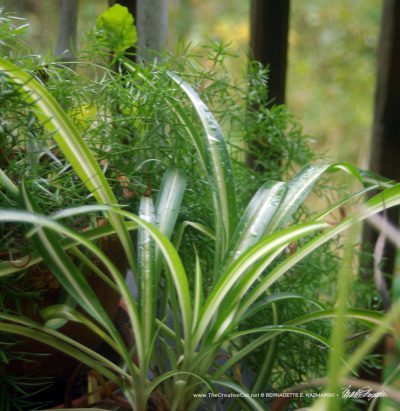
Outdoor plants and your pets
The greatest caution where your pets are concerned are the plants themselves and any chemicals that may have been used on them. Nearly all tropical plants, which includes most of the annuals whose bloom we enjoy all summer, are toxic to most dogs, cats, rabbits, ferrets, birds and other animals that have any ability to chew on them.
In the wild, animals are biologically conditioned to know what is and isn’t toxic in their environment, but indoors they are encountering a house full of greenery they know nothing about. It’s a natural reaction for animals to taste new things in the environment, and some pets truly enjoy chewing away at your indoor jungle.
You can’t really punish them for following what seems to be a natural impulse and a physical need. We don’t really know why cats, obligate carnivores, chew on grasses and green things, but it may be to help cleanse their mouth and digestive system, and to add fiber to their primarily protein diet to aid in elimination. It may just be because it’s there.
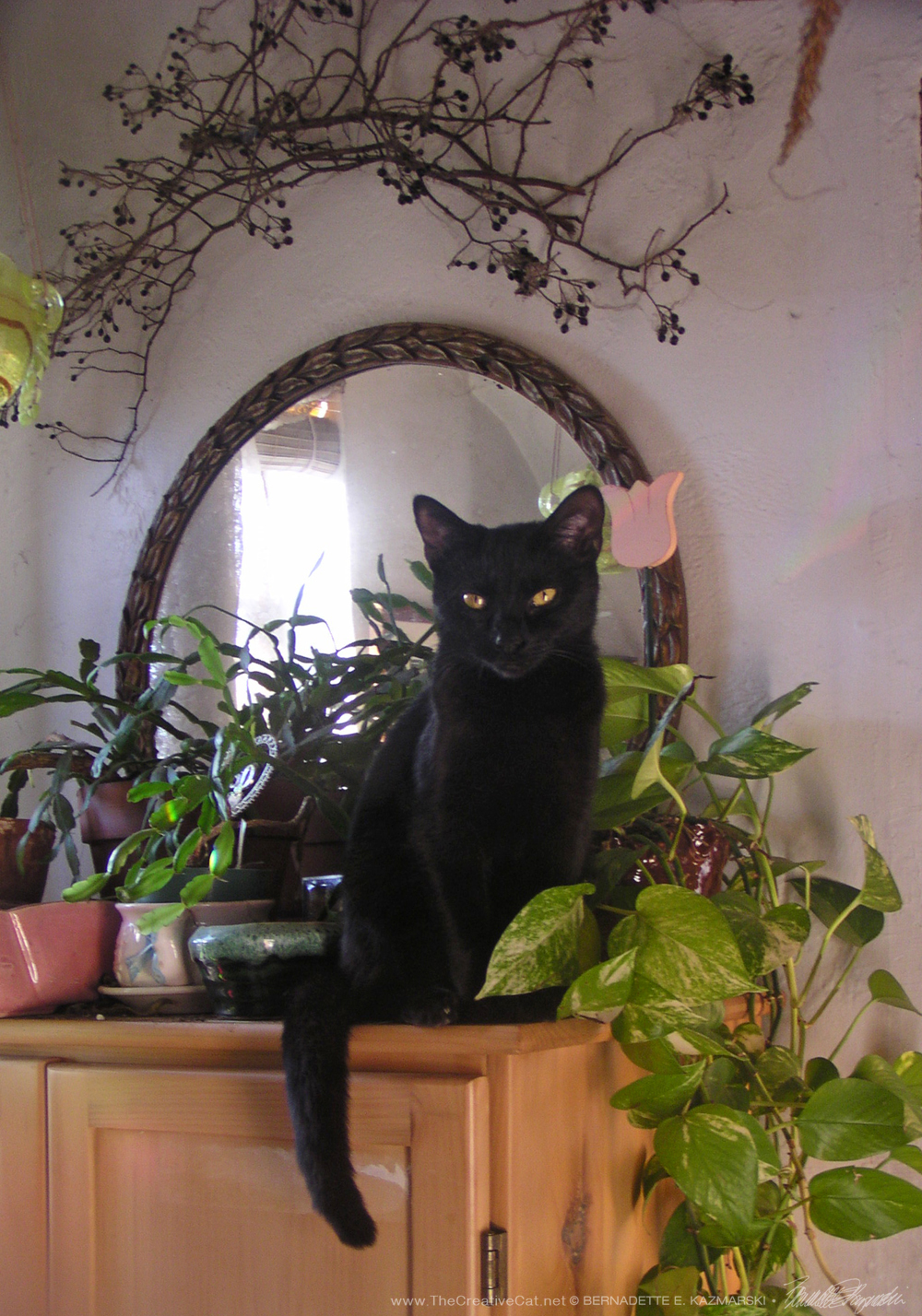
An indoor pet will take what they can get to simulate the natural outdoor environment they crave, digging in the soil of a potted plant or making a bed of a lush, healthy pot of foliage. Cats and dogs aren’t necessarily particular in what they’ll nibble on; generally they’ll try anything green, and some cats will completely chew down a plant that can’t have tasted very good and wasn’t very easy to chew.
While it may be amusing if you’re not too attached to your plants, it can be EXTREMELY DANGEROUS to your pets. Several common houseplants, or plants we bring in for some holidays or for winter, are deadly, and another longer list can cause a range of symptoms from temporary discomfort to permanent health problems. I have several articles on this site that list these plants in particular and include links to online resources with a wealth of information; these resources are also listed at the end of this article. But be aware that anything that grows from a bulb or is in the lily family should not come inside—all lilies, including popular calla and alstromeria, are toxic to cats. Read “Leave the Lilies Outside”.
Chemicals in the soil
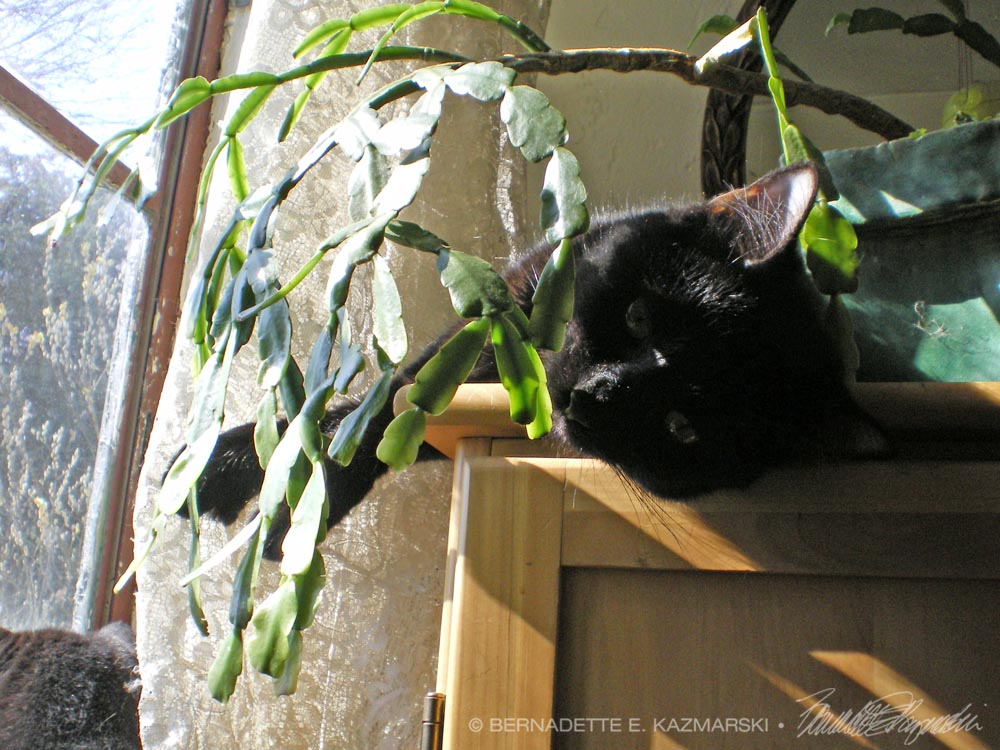
Not only the plants may have toxicity but also the soil. Many chemical fertilizers you may have used on them through the summer such as plant growth sticks and pellets and even watering with a liquid chemical fertilizer leave a residue in the soil.
Some of my lovely felines find loose soil and think I’ve installed a natural litterbox, and other pets will actually eat the soil, especially if they have some lack of minerals in their diet (this is common with anemic pets or those in renal failure).
I use my own mix of compost and peat moss and top off with fresh compost and water with compost tea (yes, tea), which is non-toxic and actually renews the soil, so I’m not concerned with toxicity in the soil when mine come indoors, but I have to cover the soil in the larger plants with wire mesh or screen that can’t be pulled away; they can and will dig in gravel, seashells, and larger rocks.
But even being totally natural in your plant’s soil base may pose a problem because soil-dwelling insects and even fungi may hitch a ride indoors. My mother and I were often surprised at finding dozens of bees in the house after bringing in our ferns which the bees had found to be a perfect overwinter nesting site as the temperatures dropped, then awakened with the warm indoor temperatures. I’ve also found mushrooms and other little fungi growing on my plants’ soil.
So whether you’ve used chemical fertilizers or not and want to bring your plants inside, completely remove the soil, clean the pot, and use new soil—and that complete changeover is actually good for the plant as well.
Chemicals on your plants
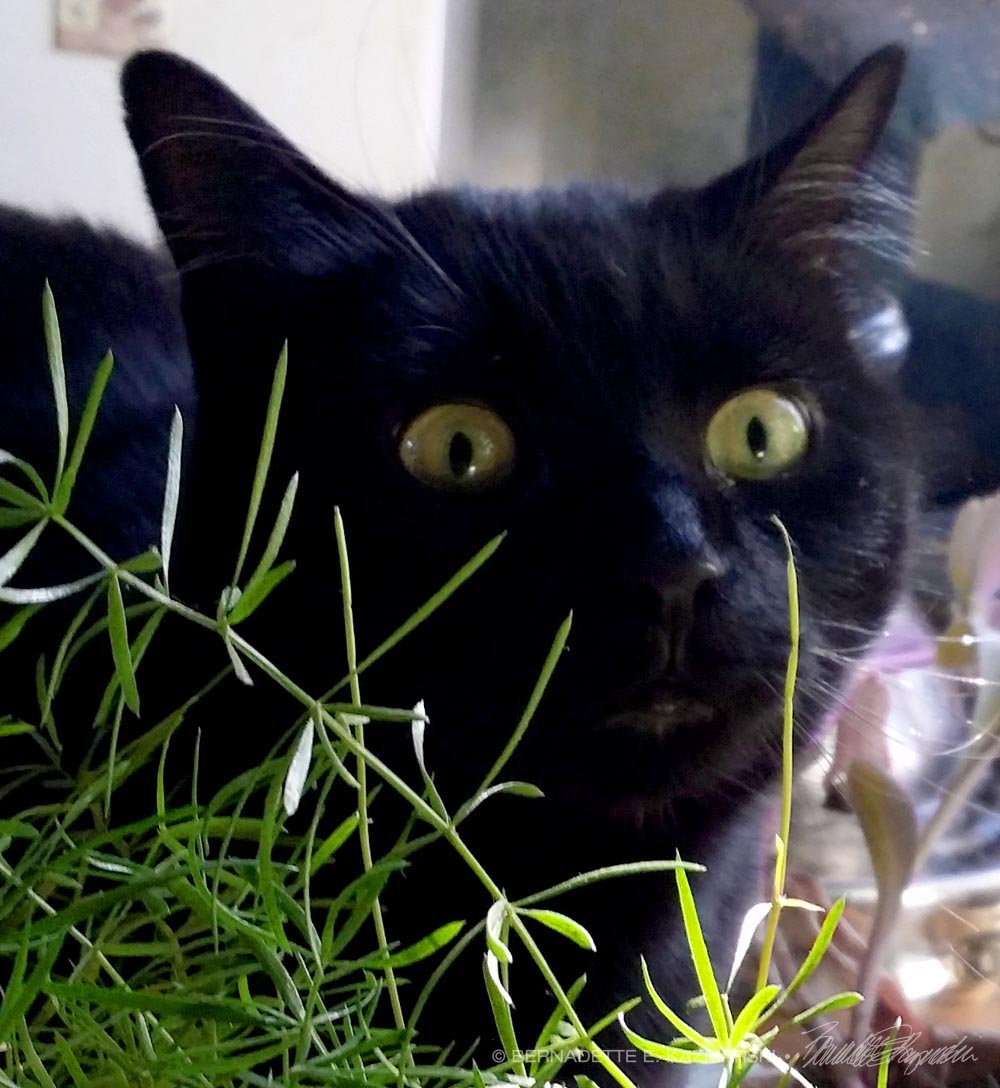
Likewise if you’ve used chemical insecticide sprays or soil treatments on your plants, you shouldn’t bring them inside, even if time has passed since you used the product. These can leave behind enough of a residue on the plant or in the plant’s leaves and stems to be toxic to your pet. Read below about alternatives to insecticides.
Keeping pets away from your plants
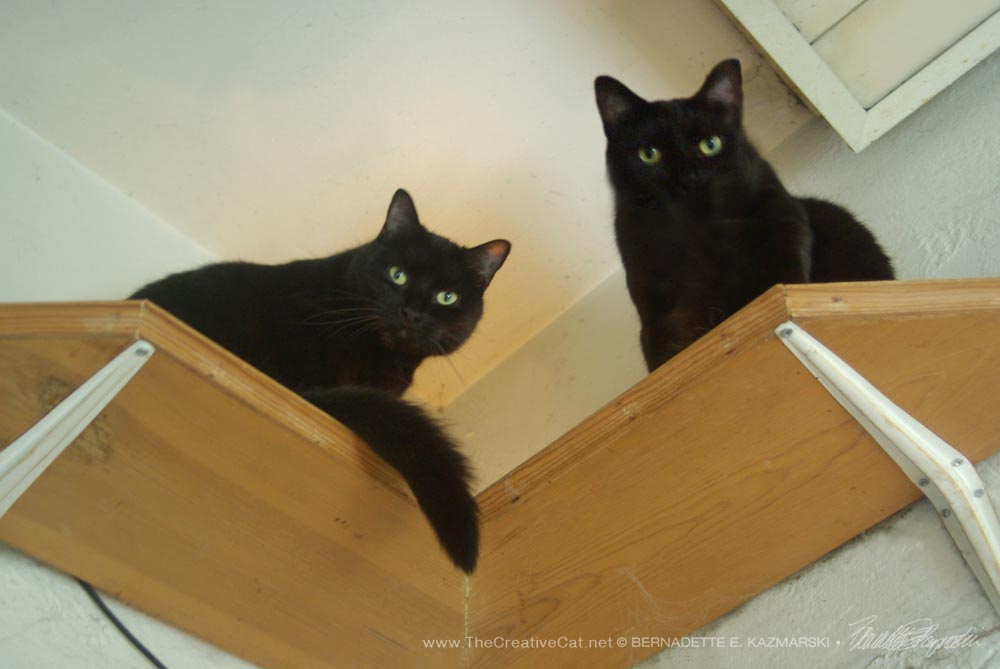
The problem is that, while you may get some pets to quite eating your plants, most will return again and again, even if they suffer discomfort from their snack. The best way to keep your pets safe from plants is to put the plants completely out of reach—bearing in mind that cats can jump five to seven times the height of their tail and can be ingenious about launching from strategic furniture to get into a hanging basket. Sometimes it is necessary to completely remove the plant from the house, no matter how much you like it.
For years my cats walked around in my plants, slept in them, occasionally took an exploratory nibble, but basically left them alone. Not so anymore. The Curious Quartet have eaten anything in their path, especially Mewsette who likes salad greens, and even the high-level shelves are no longer out of reach from this young and curious group, as you see above. I miss my houseplants, but between falling heavy clay pots and dining on every plant I had to remove just about everything. Over the years I’ve gotten creative with finding shops and public spaces to take my houseplants, offering to stop by weekly or so to take care of them.
Alternatives to insecticides before bringing inside
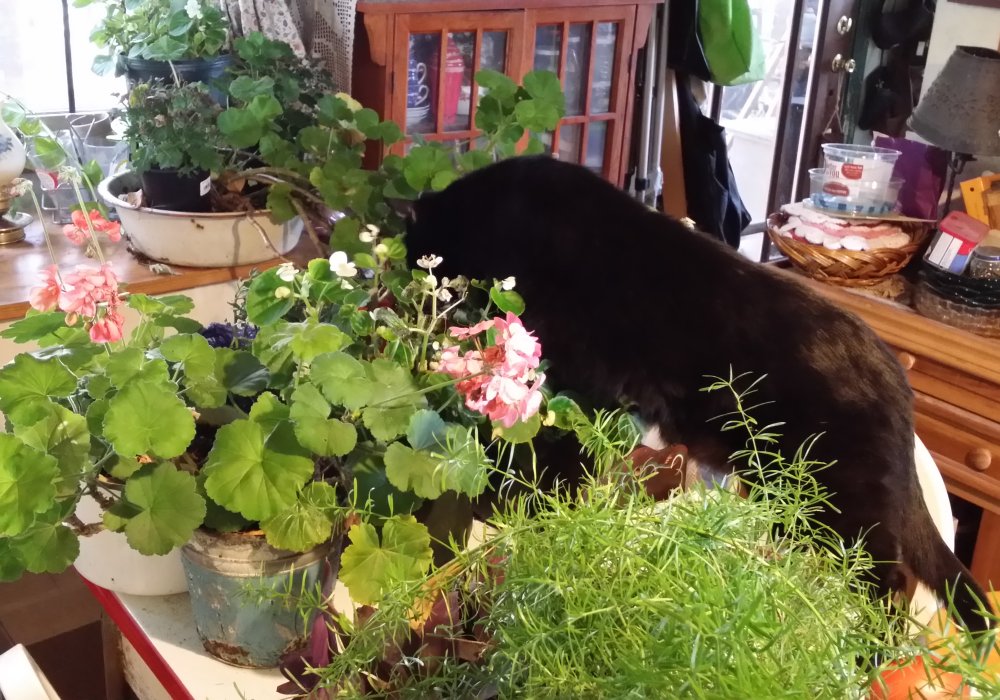
You may also notice insects who’ve made a tidy home on your plants, especially as cold weather sets in. Spiders, aphids, even bees and stinkbugs, are naturally camouflaged along the stems or undersides of leaves on plants.
Rather than spray them down with a chemical insecticide spray, you can go a long way by cutting the affected branches and throwing them away, insects and all. Plants often need to be trimmed back when they come inside anyway.
With most insects, a good blast of water from a hose will knock them off. If the plant is too delicate or you can’t rid the plant of all of them, you can use a detergent preparation, either a homemade solution of one tablespoon of dish detergent (any brand will do, it’s the detergent itself that’s the active ingredient) in a quart of water used in a spray bottle, or look for a commercial “insecticidal soap”. The detergent works in varying ways with various insects, but tends to coats the skin, absorb into cells or break down an insect’s waxy coating and they die without their natural protection.
I have nearly always had bees build a nest in one of my ferns, so a careful blast with the hose is generally advisable for ferns, spider plants and other tropical plants with dense rootballs and grassy foliage if you can’t change out the soil as mentioned above.
What plants to bring indoors
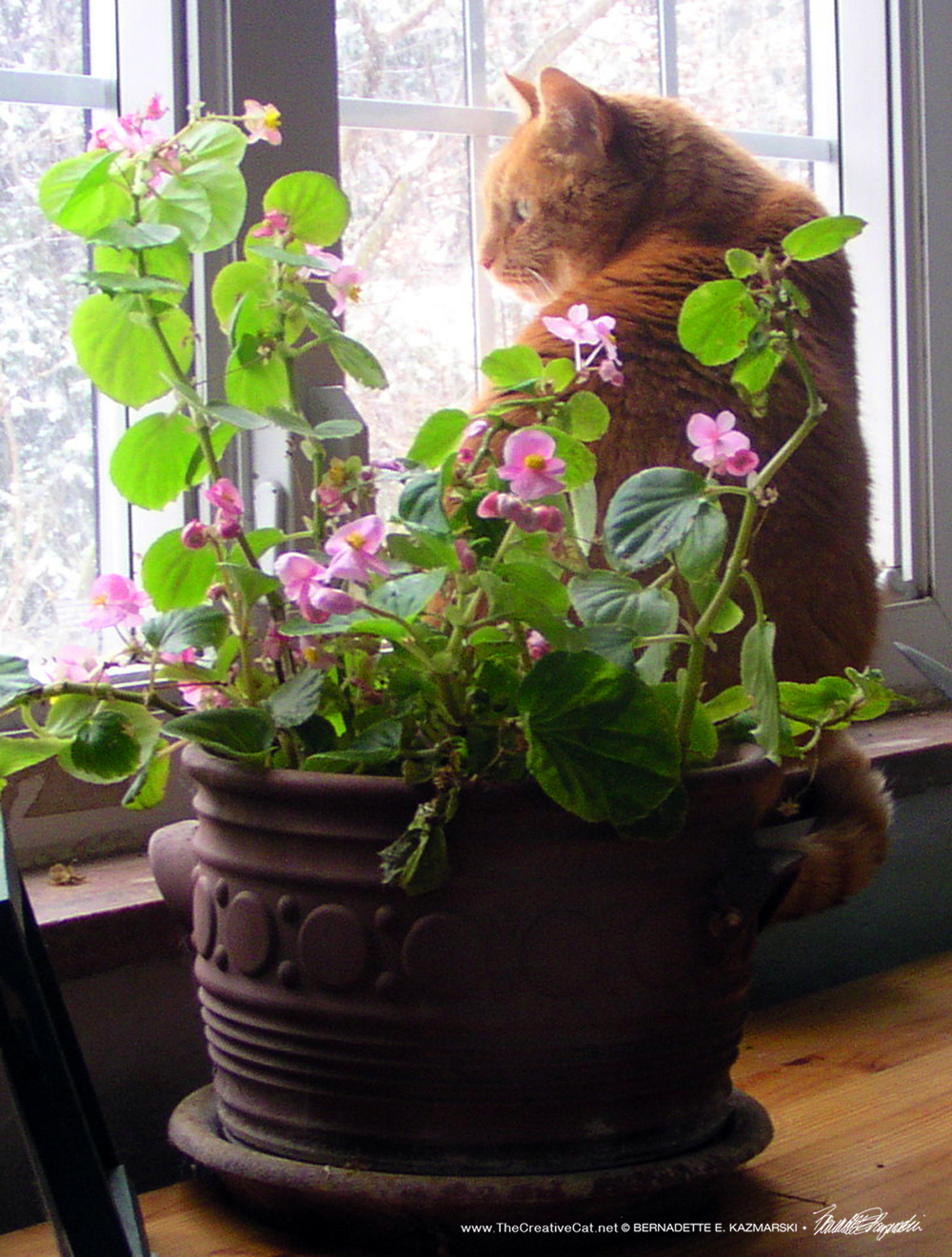
Generally, I’ll bring anything indoors that’s already in a pot and thriving; digging plants such as herbs and half-hardy perennials out of the soil is not difficult, but an entirely different project. If the plant is starting to show signs of wear and tear, like my basil or petunias, I’ll pluck the good basil leaves to cook with or dry, cut the petunias for a bouquet, and toss the rest in the compost.
Most plants which have grown outdoors in summer’s humid air need more humidity than the average heated indoor household gives it, so entryways and hallways that don’t have a direct heat source are ideal, and of course the bathroom is like a sauna for plants. Here are a few ideas for plants that do well indoors.
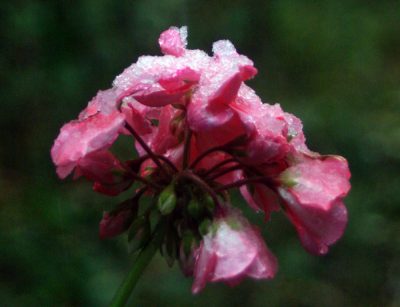
People have been overwintering geraniums for decades using a variety of methods—it’s even mentioned in several farm magazines from the 1800s. I had one huge geranium I called “Big Pink” for 13 years that I kept in the same pot, carried out to the same place on my front porch in the spring and back into the same spot in the basement in the fall.
My mother would knock the soil off the roots of her big red geraniums for the window box under the front window, trim them back and hang them upside down in a corner of the basement; some people store them in paper bags like tender bulbs. I faithfully did this until one year I only had time to bring them in and set them on a table in the corner of the basement. My basement stays fairly cool but it’s damp, and as soon as the days began to lengthen the plants grew new leaves and were blooming in January.
You can also keep them on a sunny windowsill and grow them like houseplants. They will continue to bloom all winter, but you’ll need to cut them back in spring or they’ll be completely leggy by summer. The good thing is you can easily root the trimmings into new geranium plants either by putting them in water on a bright, not sunny, windowsill, or tucking the cut end of the cutting into soil and keeping it well watered on a sunny windowsill. Aside from Big Pink and a few others I have now, most plants last about three to five years, so nearly all the geraniums I have now are cuttings from prior geraniums. I purchased a pure white and a fire-engine red last year to add to my collection.
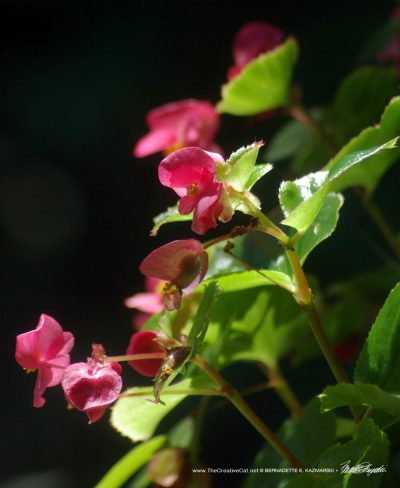
Begonias are sold as house plants as often as annual bedding plants with pink or white flowers and green or burgundy leaves, and move indoors easily. They may bloom all winter but will usually die back and lose leaves and blossoms, needing a period of rest. The bare stems can be trimmed and new stems will branch from there, blooming again in just a few months. But though begonias look delicate they are lasting; last year a planter of my begonias died back indoors to the point where little could be seen except a few sticks and a leaf or two. I put it out in the spring rains and it resurrected to bloom all summer on the deck rail again.
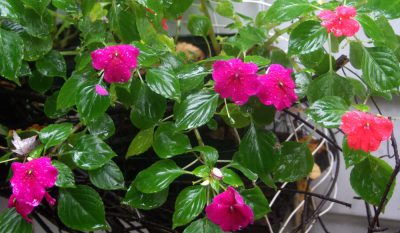
Similar to begonias, impatiens will overwinter nicely if cut back and kept small through the winter, even just a rosette of leaves on the soil, and the soil kept damp. They usually won’t bloom again while inside and any leaves will be tiny and new growth leggy, but you’ll have plants that will take off as soon as you get them outside.
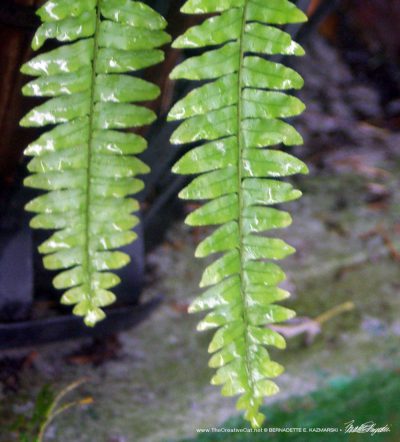
For years I had choleus as a houseplant and never realized it could grow outdoors until I saw it in a garden center. After that I took cuttings each spring for my outdoor choleus and brought as many indoors as I could. Most varieties of choleus can move in and out though they always use lose most of their leaves and need a good trim, but leaf out when the days grow longer.
And it’s hard to toss out a fern that’s been happily swaying back and forth in the breeze, but be especially careful of bees and spiders as mentioned above. I’ve safely brought ferns inside for years, though these are the most difficult to find a comfortable spot since my house is so small. They’ve usually ended up decorating a lobby somewhere.
Also read:
Leave the Lilies Outside, more information on toxic plants and tips on keeping cats out of plants, plus a downloadable guide to toxic plants.
A Green Party for Your Pets? starting a garden of greens that are safe for your cat
Other resources
Your local veterinarians and shelters often have lists of toxic flora has handouts, and plenty of resources exist on the internet.
And as far as those flowers, you just can’t go wrong with roses!
ASPCA Searchable Database of Plants
Pet poisoning emergencies
ASPCA Online Poison Control Center including plants, medications, cleaning products and most other toxins your pet could come in contact with: www.aspca.org/pet-care/poison-control/
Both of the hotlines below are available 24/7/365 providing live consultation for animal poison emergencies. The credit card charge covers the initial phone consultation and any follow-up consultation you or your veterinarian may need for your case. For instance, if you call and find out that the toxin your cat has come in contact with needs to be treated by a veterinarian, you can give your case number to your veterinarian and they can also call the hotline for ecommendations on treatment. There is no further charge.
ASPCA ANIMAL POISON CONTROL CENTER 888-426-4435, www.aspca.org/pet-care/poison-control/
$65 credit card charge covers the initial phone consultation and any follow-up consultation.
PET POISON HELPLINE 800-213-6680, www.petpoisonhelpline.com
Affiliated with the University of Minnesota Veterinary Medical Center, $35 credit card charge.
. . . . . . .
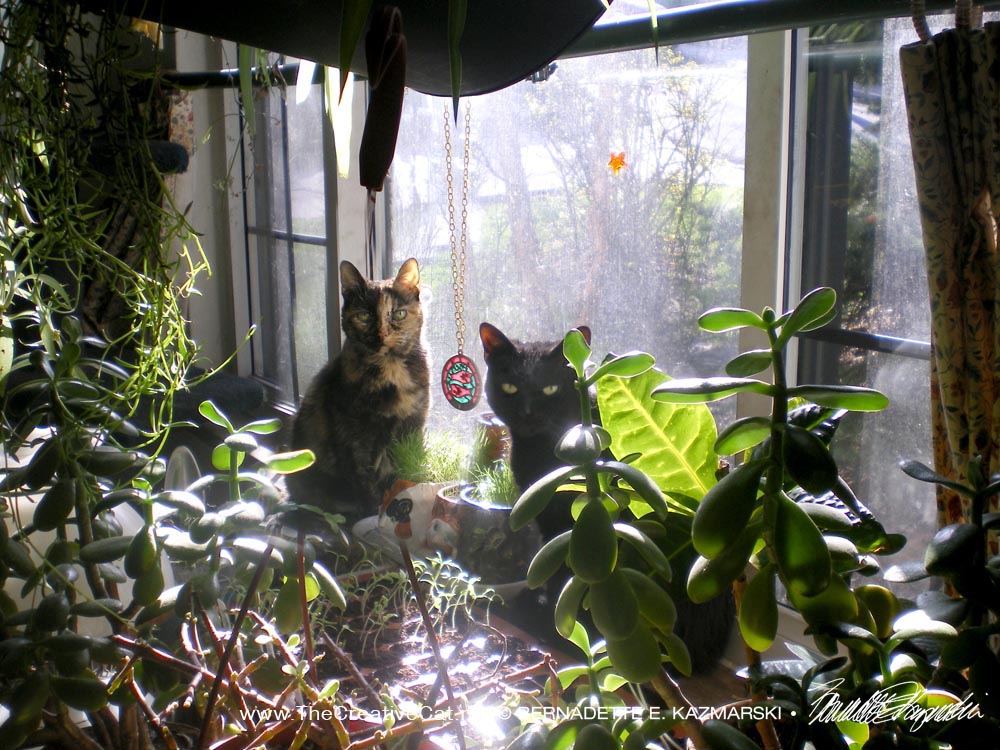
Read other articles about “Living Green With Pets” and in the category of “Health and Safety”
Subscribe to The Creative Cat on your Kindle

Start with a 14-day free trial. You can cancel at any time during the free trial period. If you enjoy your subscription, do nothing and it will automatically continue at the regular monthly price of 99 cents. Click here to subscribe to The Creative Cat on your Kindle.
All images and text used on this site are copyrighted to Bernadette E. Kazmarski unless otherwise noted and may not be used without my written permission, although links to your site are more than welcome and are shared. Please ask if you are interested in using and image or story in a print or internet publication. If you are interested in purchasing a print of an image or a product including it, check my animal and nature website Portraits of Animals to see if I have it available already. If you don’t find it there, visit Ordering Custom Artwork for more information on a custom greeting card, print or other item. Subscribe to The Creative Cat Preview E-newsletter. © 2022 | www.TheCreativeCat.net | Published by Bernadette E. Kazmarski Weekly schedule of features: Sunday: Essays, Pet Loss, Poetry, The Artist’s Life Monday: Adoptable Cats, TNR & Shelters Tuesday: Rescue Stories Wednesday: Commissioned Portrait or Featured Artwork Thursday: New Merchandise Friday: Book Review, Health and Welfare, Advocacy Saturday: Your Backyard Wildlife Habitat, Living Green With Pets, Creating With Cats And sometimes, I just throw my hands in the air and have fun!

Copyright
Subscribe to my e-newsletter
PORTRAITS OF ANIMALS WEBSITE
FACEBOOK | TWITTER | LINKEDIN | PINTEREST | TUMBLR | INSTAGRAM | YOUTUBE| EMAIL
| PATREON
© 2016 | www.TheCreativeCat.net | Published by Bernadette E. Kazmarski
—
Weekly schedule of features:
Sunday: Essays, Pet Loss, Poetry, The Artist’s Life
Monday: Adoptable Cats, TNR & Shelters
Tuesday: Rescue Stories
Wednesday: Commissioned Portrait or Featured Artwork
Thursday: New Merchandise
Friday: Book Review, Health and Welfare, Advocacy
Saturday: Your Backyard Wildlife Habitat, Living Green With Pets, Creating With Cats
And sometimes, I just throw my hands in the air and have fun!
—

